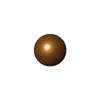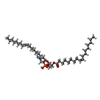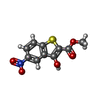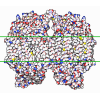[English] 日本語
 Yorodumi
Yorodumi- PDB-7xmd: Cryo-EM structure of Cytochrome bo3 from Escherichia coli, the st... -
+ Open data
Open data
- Basic information
Basic information
| Entry | Database: PDB / ID: 7xmd | |||||||||
|---|---|---|---|---|---|---|---|---|---|---|
| Title | Cryo-EM structure of Cytochrome bo3 from Escherichia coli, the structure complexed with an allosteric inhibitor N4 | |||||||||
 Components Components |
| |||||||||
 Keywords Keywords | OXIDOREDUCTASE / respiratory enzyme / membrane protein / heme protein / allosteric inhibitor | |||||||||
| Function / homology |  Function and homology information Function and homology informationoxidoreduction-driven active transmembrane transporter activity / cytochrome o ubiquinol oxidase complex / ubiquinol oxidase (H+-transporting) / cytochrome bo3 ubiquinol oxidase activity / aerobic electron transport chain / oxidoreductase activity, acting on diphenols and related substances as donors, oxygen as acceptor / cytochrome-c oxidase activity / ubiquinone binding / electron transport coupled proton transport / proton transmembrane transporter activity ...oxidoreduction-driven active transmembrane transporter activity / cytochrome o ubiquinol oxidase complex / ubiquinol oxidase (H+-transporting) / cytochrome bo3 ubiquinol oxidase activity / aerobic electron transport chain / oxidoreductase activity, acting on diphenols and related substances as donors, oxygen as acceptor / cytochrome-c oxidase activity / ubiquinone binding / electron transport coupled proton transport / proton transmembrane transporter activity / ATP synthesis coupled electron transport / aerobic respiration / respiratory electron transport chain / electron transfer activity / copper ion binding / heme binding / plasma membrane Similarity search - Function | |||||||||
| Biological species |  | |||||||||
| Method | ELECTRON MICROSCOPY / single particle reconstruction / cryo EM / Resolution: 2.99 Å | |||||||||
 Authors Authors | Nishida, Y. / Shigematsu, H. / Iwamoto, T. / Takashima, S. / Shintani, Y. | |||||||||
| Funding support |  Japan, 2items Japan, 2items
| |||||||||
 Citation Citation |  Journal: Nat Commun / Year: 2022 Journal: Nat Commun / Year: 2022Title: Identifying antibiotics based on structural differences in the conserved allostery from mitochondrial heme-copper oxidases. Authors: Yuya Nishida / Sachiko Yanagisawa / Rikuri Morita / Hideki Shigematsu / Kyoko Shinzawa-Itoh / Hitomi Yuki / Satoshi Ogasawara / Ken Shimuta / Takashi Iwamoto / Chisa Nakabayashi / Waka ...Authors: Yuya Nishida / Sachiko Yanagisawa / Rikuri Morita / Hideki Shigematsu / Kyoko Shinzawa-Itoh / Hitomi Yuki / Satoshi Ogasawara / Ken Shimuta / Takashi Iwamoto / Chisa Nakabayashi / Waka Matsumura / Hisakazu Kato / Chai Gopalasingam / Takemasa Nagao / Tasneem Qaqorh / Yusuke Takahashi / Satoru Yamazaki / Katsumasa Kamiya / Ryuhei Harada / Nobuhiro Mizuno / Hideyuki Takahashi / Yukihiro Akeda / Makoto Ohnishi / Yoshikazu Ishii / Takashi Kumasaka / Takeshi Murata / Kazumasa Muramoto / Takehiko Tosha / Yoshitsugu Shiro / Teruki Honma / Yasuteru Shigeta / Minoru Kubo / Seiji Takashima / Yasunori Shintani /  Abstract: Antimicrobial resistance (AMR) is a global health problem. Despite the enormous efforts made in the last decade, threats from some species, including drug-resistant Neisseria gonorrhoeae, continue to ...Antimicrobial resistance (AMR) is a global health problem. Despite the enormous efforts made in the last decade, threats from some species, including drug-resistant Neisseria gonorrhoeae, continue to rise and would become untreatable. The development of antibiotics with a different mechanism of action is seriously required. Here, we identified an allosteric inhibitory site buried inside eukaryotic mitochondrial heme-copper oxidases (HCOs), the essential respiratory enzymes for life. The steric conformation around the binding pocket of HCOs is highly conserved among bacteria and eukaryotes, yet the latter has an extra helix. This structural difference in the conserved allostery enabled us to rationally identify bacterial HCO-specific inhibitors: an antibiotic compound against ceftriaxone-resistant Neisseria gonorrhoeae. Molecular dynamics combined with resonance Raman spectroscopy and stopped-flow spectroscopy revealed an allosteric obstruction in the substrate accessing channel as a mechanism of inhibition. Our approach opens fresh avenues in modulating protein functions and broadens our options to overcome AMR. | |||||||||
| History |
|
- Structure visualization
Structure visualization
| Structure viewer | Molecule:  Molmil Molmil Jmol/JSmol Jmol/JSmol |
|---|
- Downloads & links
Downloads & links
- Download
Download
| PDBx/mmCIF format |  7xmd.cif.gz 7xmd.cif.gz | 229.2 KB | Display |  PDBx/mmCIF format PDBx/mmCIF format |
|---|---|---|---|---|
| PDB format |  pdb7xmd.ent.gz pdb7xmd.ent.gz | 178.2 KB | Display |  PDB format PDB format |
| PDBx/mmJSON format |  7xmd.json.gz 7xmd.json.gz | Tree view |  PDBx/mmJSON format PDBx/mmJSON format | |
| Others |  Other downloads Other downloads |
-Validation report
| Summary document |  7xmd_validation.pdf.gz 7xmd_validation.pdf.gz | 1.5 MB | Display |  wwPDB validaton report wwPDB validaton report |
|---|---|---|---|---|
| Full document |  7xmd_full_validation.pdf.gz 7xmd_full_validation.pdf.gz | 1.5 MB | Display | |
| Data in XML |  7xmd_validation.xml.gz 7xmd_validation.xml.gz | 51.3 KB | Display | |
| Data in CIF |  7xmd_validation.cif.gz 7xmd_validation.cif.gz | 75.2 KB | Display | |
| Arichive directory |  https://data.pdbj.org/pub/pdb/validation_reports/xm/7xmd https://data.pdbj.org/pub/pdb/validation_reports/xm/7xmd ftp://data.pdbj.org/pub/pdb/validation_reports/xm/7xmd ftp://data.pdbj.org/pub/pdb/validation_reports/xm/7xmd | HTTPS FTP |
-Related structure data
| Related structure data |  33294MC  7xmaC  7xmbC  7xmcC M: map data used to model this data C: citing same article ( |
|---|---|
| Similar structure data | Similarity search - Function & homology  F&H Search F&H Search |
- Links
Links
- Assembly
Assembly
| Deposited unit | 
|
|---|---|
| 1 |
|
- Components
Components
-Cytochrome bo(3) ubiquinol oxidase subunit ... , 3 types, 3 molecules ACD
| #1: Protein | Mass: 74424.469 Da / Num. of mol.: 1 Source method: isolated from a genetically manipulated source Source: (gene. exp.)   References: UniProt: P0ABI8, ubiquinol oxidase (H+-transporting) |
|---|---|
| #3: Protein | Mass: 22642.566 Da / Num. of mol.: 1 Source method: isolated from a genetically manipulated source Source: (gene. exp.)   |
| #4: Protein | Mass: 12037.402 Da / Num. of mol.: 1 Source method: isolated from a genetically manipulated source Source: (gene. exp.)   |
-Protein , 1 types, 1 molecules B
| #2: Protein | Mass: 36209.559 Da / Num. of mol.: 1 Source method: isolated from a genetically manipulated source Source: (gene. exp.)  Gene: cyoA, ACU57_11830, AM464_19145, APX88_10780, AWP93_14560, BANRA_03634, BEA19_24285, BJI68_14080, BJJ90_20095, BK383_14750, BMC79_002872, BO068_001687, BOB65_000403, BON66_08870, BON73_06180, ...Gene: cyoA, ACU57_11830, AM464_19145, APX88_10780, AWP93_14560, BANRA_03634, BEA19_24285, BJI68_14080, BJJ90_20095, BK383_14750, BMC79_002872, BO068_001687, BOB65_000403, BON66_08870, BON73_06180, BON74_21890, BON77_14335, BON80_10695, BON86_25900, BON87_05825, BON89_00395, BON92_15695, BON93_19065, BON98_18690, BSR05_07160, BXT93_14110, BZL69_16590, C2121_000756, C5N07_12950, CA593_00980, CDC27_01080, CDL36_18475, CDL37_08970, CQP61_20675, CR539_06390, CT143_00345, CXJ73_004380, D0X26_07630, D3822_17775, D3Y67_14555, D9E34_22950, D9J03_07430, DAH17_06675, DAH34_12595, DAH36_12985, DD762_23785, DKP82_19825, DN627_04300, DNQ45_18500, DNX30_04955, DTM16_23740, DTM45_11185, DU321_07410, DXT70_02705, E2119_01520, E2122_05970, E2131_02675, E2135_01205, E4K51_12275, E5P26_04320, E5P27_05630, E5P28_11110, E5P29_09785, E5P31_06375, E5P32_04100, E5P34_04850, E5P35_04720, E5P36_01955, E5P40_03855, E5S36_14935, E5S46_14035, E5S51_13330, E5S58_14090, E5S61_17450, EC3234A_4c01010, EI021_16450, EIA08_09775, EIZ93_01035, EL79_3413, EL80_3367, ELT17_06040, ELT20_08135, ELT41_07160, ELT49_07745, ELT51_19775, ELU85_09175, ELV10_08020, ELV16_21785, ELX48_13290, ELX76_14920, ELX85_08605, EVY14_00280, ExPECSC038_03272, EYV17_02895, EYV18_09930, EYY21_23390, F2N31_13445, F3N40_15010, F9S83_01735, F9V24_00335, FA849_16035, FA868_02450, FE587_05330, FEJ01_04230, FEL34_02865, FGG80_03370, FGY90_08715, FHD44_10295, FJQ51_12155, FQF29_11475, FTV93_12140, FV293_05915, FWK02_10070, G3813_001713, G4A38_05615, G5603_08425, GIB53_01940, GKF86_04705, GKF89_04260, GLW94_08520, GQM13_16545, GQW68_14795, GQW80_03945, GRW05_22945, GRW57_14390, GRW81_04315, GSY44_02240, GTP88_03650, GUB08_11340, H0O53_01600, HIN64_001359, HJQ60_002319, HJS37_002124, HJU54_001612, HL601_03105, HLZ50_08430, HMJ82_07910, HMU48_15410, HMV41_13070, HMV95_11775, HNC36_06575, HNC59_10400, HNC66_06810, HNC99_09295, HND12_08495, HVW04_08795, HVX16_19275, HX136_19320, IA00_004007, IH772_12955, IT029_003268, J0541_001708, JNP96_06590, NCTC10082_01037, NCTC10764_05312, NCTC10974_04302, NCTC11112_03815, NCTC12950_04133, NCTC13148_06650, NCTC8008_03342, NCTC8450_01418, NCTC8500_04220, NCTC8621_03944, NCTC9037_03917, NCTC9044_03552, NCTC9117_04753, PGD_02879, SAMEA3472067_03229, SAMEA3751407_02102, WP2S18E08_34950 Production host:  |
|---|
-Non-polymers , 6 types, 7 molecules 










| #5: Chemical | ChemComp-HEO / | ||||
|---|---|---|---|---|---|
| #6: Chemical | ChemComp-HEM / | ||||
| #7: Chemical | ChemComp-CU / | ||||
| #8: Chemical | | #9: Chemical | ChemComp-JYR / | #10: Chemical | ChemComp-UNX / | |
-Details
| Has ligand of interest | N |
|---|
-Experimental details
-Experiment
| Experiment | Method: ELECTRON MICROSCOPY |
|---|---|
| EM experiment | Aggregation state: PARTICLE / 3D reconstruction method: single particle reconstruction |
- Sample preparation
Sample preparation
| Component | Name: Cytochrome bo3 ubiquinol oxidase / Type: COMPLEX / Entity ID: #2-#4 / Source: RECOMBINANT | ||||||||||||||||||||||||||||||
|---|---|---|---|---|---|---|---|---|---|---|---|---|---|---|---|---|---|---|---|---|---|---|---|---|---|---|---|---|---|---|---|
| Molecular weight | Value: 0.144 MDa / Experimental value: NO | ||||||||||||||||||||||||||||||
| Source (natural) | Organism:  | ||||||||||||||||||||||||||||||
| Source (recombinant) | Organism:  | ||||||||||||||||||||||||||||||
| Buffer solution | pH: 7.2 | ||||||||||||||||||||||||||||||
| Buffer component |
| ||||||||||||||||||||||||||||||
| Specimen | Conc.: 13 mg/ml / Embedding applied: NO / Shadowing applied: NO / Staining applied: NO / Vitrification applied: YES | ||||||||||||||||||||||||||||||
| Specimen support | Grid material: COPPER / Grid mesh size: 300 divisions/in. / Grid type: Quantifoil R1.2/1.3 | ||||||||||||||||||||||||||||||
| Vitrification | Instrument: FEI VITROBOT MARK IV / Cryogen name: ETHANE / Humidity: 100 % / Chamber temperature: 281 K |
- Electron microscopy imaging
Electron microscopy imaging
| Microscopy | Model: TFS GLACIOS |
|---|---|
| Electron gun | Electron source:  FIELD EMISSION GUN / Accelerating voltage: 200 kV / Illumination mode: FLOOD BEAM FIELD EMISSION GUN / Accelerating voltage: 200 kV / Illumination mode: FLOOD BEAM |
| Electron lens | Mode: BRIGHT FIELD / Nominal defocus max: 2000 nm / Nominal defocus min: 500 nm |
| Specimen holder | Specimen holder model: FEI TITAN KRIOS AUTOGRID HOLDER |
| Image recording | Electron dose: 50 e/Å2 / Detector mode: COUNTING / Film or detector model: GATAN K2 SUMMIT (4k x 4k) / Num. of real images: 7173 |
- Processing
Processing
| Software | Name: PHENIX / Version: 1.19.2_4158: / Classification: refinement | ||||||||||||||||||||||||
|---|---|---|---|---|---|---|---|---|---|---|---|---|---|---|---|---|---|---|---|---|---|---|---|---|---|
| EM software |
| ||||||||||||||||||||||||
| CTF correction | Type: PHASE FLIPPING AND AMPLITUDE CORRECTION | ||||||||||||||||||||||||
| 3D reconstruction | Resolution: 2.99 Å / Resolution method: FSC 0.143 CUT-OFF / Num. of particles: 67692 / Symmetry type: POINT | ||||||||||||||||||||||||
| Atomic model building | Protocol: FLEXIBLE FIT | ||||||||||||||||||||||||
| Refine LS restraints |
|
 Movie
Movie Controller
Controller



 PDBj
PDBj













